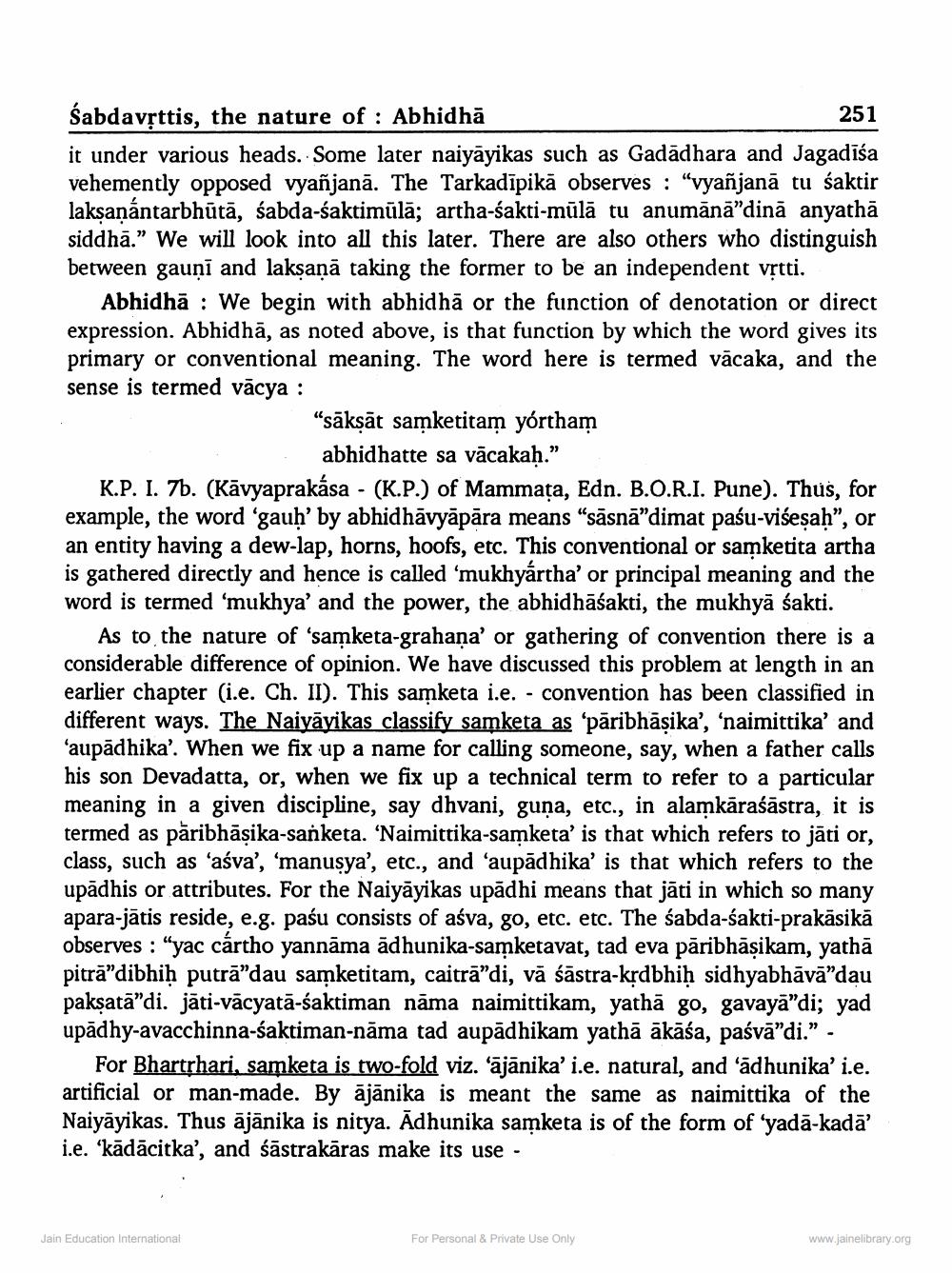________________
Sabdavṛttis, the nature of: Abhidhā
251
it under various heads. Some later naiyayikas such as Gadadhara and Jagadīśa vehemently opposed vyañjanā. The Tarkadīpikā observes: "vyañjanā tu śaktir lakṣaṇántarbhūtā, śabda-śaktimūlā; artha-śakti-mūlā tu anumānā”dinā anyathā siddhā." We will look into all this later. There are also others who distinguish between gauņi and lakṣaṇā taking the former to be an independent vṛtti.
Abhidha We begin with abhidhā or the function of denotation or direct expression. Abhidhā, as noted above, is that function by which the word gives its primary or conventional meaning. The word here is termed vācaka, and the sense is termed vācya :
"sākṣāt samketitam yórtham abhidhatte sa vācakaḥ."
K.P. I. 7b. (Kavyaprakása - (K.P.) of Mammata, Edn. B.O.R.I. Pune). Thus, for example, the word 'gauḥ' by abhidhāvyāpāra means "sāsnā”dimat paśu-viseṣaḥ", or an entity having a dew-lap, horns, hoofs, etc. This conventional or samketita artha is gathered directly and hence is called 'mukhyartha' or principal meaning and the word is termed 'mukhya' and the power, the abhidhāśakti, the mukhyā śakti.
As to the nature of 'samketa-grahaṇa' or gathering of convention there is a considerable difference of opinion. We have discussed this problem at length in an earlier chapter (i.e. Ch. II). This samketa i.e. - convention has been classified in different ways. The Naiyāyikas classify samketa as 'pāribhāṣika', 'naimittika' and 'aupādhika'. When we fix up a name for calling someone, say, when a father calls his son Devadatta, or, when we fix up a technical term to refer to a particular meaning in a given discipline, say dhvani, guṇa, etc., in alamkāraśāstra, it is termed as paribhāṣika-sanketa. 'Naimittika-samketa' is that which refers to jāti or, class, such as 'aśva', 'manusya', etc., and 'aupādhika' is that which refers to the upādhis or attributes. For the Naiyāyikas upādhi means that jāti in which so many apara-jātis reside, e.g. paśu consists of aśva, go, etc. etc. The śabda-śakti-prakāsikā observes: "yac cártho yannāma adhunika-samketavat, tad eva pāribhāṣikam, yathā pitrā”dibhiḥ putrā”dau samketitam, caitrā”di, vā śāstra-kṛdbhiḥ sidhyabhāvā❞dau pakṣatā"di. jāti-vācyatā-śaktiman nāma naimittikam, yathā go, gavayā"di; yad upadhy-avacchinna-śaktiman-nāma tad aupādhikam yathā ākāśa, paśvā❞di." -
For Bhartṛhari, samketa is two-fold viz. ‘ājānika' i.e. natural, and 'adhunika' i.e. artificial or man-made. By ājānika is meant the same as naimittika of the Naiyāyikas. Thus ājānika is nitya. Ādhunika samketa is of the form of 'yadā-kadā' i.e. 'kādācitka', and śāstrakāras make its use -
Jain Education International
For Personal & Private Use Only
www.jainelibrary.org




